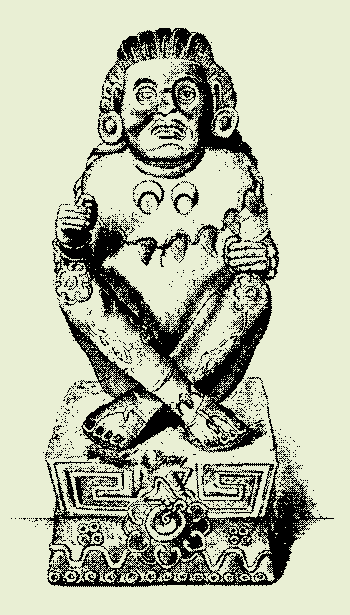Xochipilli

In the museum of Anthropology and History of Mexico City is found Xochipilli seated upon a beautiful carved basaltic cube. The knees on high and his legs crossed as the cross of Saint Andrew, his hands above his knees with their respective index and thumbs in contact. His sight is towards the infinite.
He wears great earrings made of jade, an armor chest with tassels that end as tiger paws or serpent’s fangs, and upon the center of his armor are shown two suns with a big half moon upon each one of them. He has bracelets and kneecaps that are finished as six petaled flowers; leg-armor with paws which seize his ankles, and upon his leg-armor there are two bellflowers whose corollas are downwardly spreading; one with six seeds and the other with fire. He is wearing cactlis whose lashes are graciously knotted upon his feet.
Xochipilli: xochith “flower” pilli, “principal” God of agriculture, flowers, music, song, poetry and dance. “Flowers and chants are the most elevated things that exist on the earth so as to enter into the ambits of the truth; “this is what the Tlamatinime taught in the Calmecac...
... the symbol of this Great Deity over his chest. The feline paws, on the tassels of his armor chest, are the same ones that at the side of the face of Tonatiuh are scratching hearts; this is a symbol of the sacrifice of emotions in the Initiate; it is impossible to reach God without such a sacrifice.
The crowds of the Nahua religion celebrated the festivity of Xochilhutl in which, during four previous days, it was commendatory, one time a day, to eat only cornbread made without salt, and if you were married to sleep separated from your spouse. The fifth day they publicly offered to Xochipilli dances and chants accompanied with teponaztli and drums, ovations of flowers recently cut and breads with honey from bees within which they placed an obsidian butterfly, a symbol of the believer’s soul.
A ceremony offered to Xochipilli had a place in the Calmecac: Calli: “house;” Mecatl: “cable, rope, long and narrow corridor within the interior rooms of a building.” Eleven children, all of them nobility’s children, while forming a circle, performed chants and dances; when dancing, they went three steps to the front and three steps in reverse, six times; at the same time, they were graciously agitating their hands.
A child kneeled in front of the fire that burned in the altar; he silently prayed for the daily bread and another child remained on guard standing at the entrance of the temple. This ceremony endured as long as the infantile dances endured, and should be celebrated in the first night when the fine silver sickle of the new moon appears in the sky. The director of the Calmecac, standing between the child who prayed and the dancers, with his forehead towards the altar and with his face impassible as the face of Xochipilli, collected the vibrations from the infantile praying and from the chants and from the dances; and while raising his dark hands towards the heavens that now represented a flower, silently pronounced the mystic and ineffable word that assigns, defines and creates, and that the children pronounced in chorus: DANTER-ILOMBER-BIR.
“Verily I say unto you, except ye be converted, and become as little children, ye shall not enter into the kingdom of heaven. Whosoever therefore shall humble himself as this little child, the same is greatest in the kingdom of heaven.” Matthew: 18:2-4 Not like those gluttonous, disobedient and spoiled brat children, but like those children who are humble and confident in their parents who give them everything that they certainly need.
We can invoke Xochipilli on Fridays from 10:00 p.m. to Saturdays at 2:00 a.m. He makes the ‘Wheel of Retribution spin in favor of those who ask him and who also deserve it. Yet, he profits for every service, because he cannot violate the Law. In the interior of the Temple of the Sun, the Ocelot Knights and the Cuauhtli Knights celebrated another ceremony on the first Thursday with the new moon; they attired
themselves with helmets made with the shape of tiger and eagle heads, all of them wore on their necks tufts made with feathers of quetzalli, a symbol of the fight that they have to sustain against evil on the earth; they also held on one of their hands a bunch of roses and on the other a mace covered with tiger skin and eagle feathers, a symbol of power; they also had bracelets on their wrists and armors on their calves. There were dances and ritualistic chants in this ceremony, and one of the Tlamatinime (mirror honored in itself, an organ of contemplation, concentrate vision of the world of things) finished the
ceremony with the following prayer:
“Lord from whom we live, owner of the ‘near’ andof the faraway,’ we give you thanks with happiness for our Lord Quetzalcoatl, who with the sacrifice of his blood and his penance made your lift to enter within us. Make us strong as he is, make us happy as he is, and make us just as he is.” “Let it be” was uttered by everybody in chorus.
Chapter 17, Book: Aztec Christic M. by Samael Aun Weor

